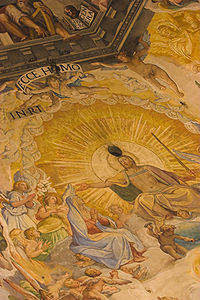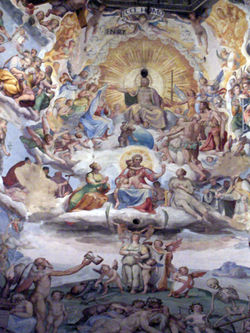
Federico Zuccari
Encyclopedia


Italy
Italy , officially the Italian Republic languages]] under the European Charter for Regional or Minority Languages. In each of these, Italy's official name is as follows:;;;;;;;;), is a unitary parliamentary republic in South-Central Europe. To the north it borders France, Switzerland, Austria and...
Mannerist
Mannerism
Mannerism is a period of European art that emerged from the later years of the Italian High Renaissance around 1520. It lasted until about 1580 in Italy, when a more Baroque style began to replace it, but Northern Mannerism continued into the early 17th century throughout much of Europe...
painter
Painting
Painting is the practice of applying paint, pigment, color or other medium to a surface . The application of the medium is commonly applied to the base with a brush but other objects can be used. In art, the term painting describes both the act and the result of the action. However, painting is...
and architect
Architect
An architect is a person trained in the planning, design and oversight of the construction of buildings. To practice architecture means to offer or render services in connection with the design and construction of a building, or group of buildings and the space within the site surrounding the...
, active both in Italy and abroad.
Biography
Zuccari was born at Sant'Angelo in VadoSant'Angelo in Vado
Sant'Angelo in Vado is a comune in the Province of Pesaro e Urbino in the Italian region Marche, located about 90 km west of Ancona and about 50 km southwest of Pesaro....
, near Urbino
Urbino
Urbino is a walled city in the Marche region of Italy, south-west of Pesaro, a World Heritage Site notable for a remarkable historical legacy of independent Renaissance culture, especially under the patronage of Federico da Montefeltro, duke of Urbino from 1444 to 1482...
(Marche
Marche
The population density in the region is below the national average. In 2008, it was 161.5 inhabitants per km2, compared to the national figure of 198.8. It is highest in the province of Ancona , and lowest in the province of Macerata...
).
His documented career as a painter began in 1550, when he moved to Rome to work under Taddeo
Taddeo Zuccari
Taddeo Zuccari was an Italian painter, one of the most popular members of the Roman mannerist school.-Biography:...
, his elder brother. He went on to complete decorations for Pius IV, and help complete the fresco decorations at the Villa Farnese at Caprarola
Villa Farnese
The Villa Farnese, also known as Villa Caprarola, is a mansion in the town of Caprarola in the province of Viterbo, Northern Lazio, Italy, approximately 50 kilometres north-west of Rome...
. He was involved in the following fresco projects:
- Decoration of the Casina Pio IVCasina Pio IVThe Casina Pio IV is a patrician villa in Vatican City which is now home to the Pontifical Academy of Sciences, the Pontifical Academy of Social Sciences and the Pontifical Academy of St. Thomas Aquinas. The predecessor of the present complex structure was begun in the spring of 1558 by Pope Paul...
, Rome - Grimani Chapel, San Francesco della VignaSan Francesco della VignaSan Francesco della Vigna is a Roman Catholic church in the Sestiere of Castello in Venice, northern Italy.-History:Along with Santa Maria Gloriosa dei Frari, this is one of two Franciscan churches in Venice. The site, originally a vineyard , was donated by Marco Ziani in 1253 for construction of...
, Venice - Pucci Chapel in the church of Trinità dei MontiTrinità dei MontiThe church of the Santissima Trinità dei Monti is a late Renaissance titular church in Rome, central Italy. It is best known for its commanding position above the Spanish Steps which lead down to the Piazza di Spagna...
, Rome - San Marcello al CorsoSan Marcello al CorsoSan Marcello al Corso is a church in Rome, Italy, devoted to Pope Marcellus I. It is located in via del Corso, the ancient via Lata, connecting Piazza Venezia to Piazza del Popolo....
, Rome - Cathedral of Orvieto (1570)
- Oratorio del GonfaloneOratorio del GonfaloneThe Oratorio del Gonfalone or Oratory of the Banner is a building in Central Rome which once housed a Catholic fraternity.Founded in 1264 under the name of the Accomandati di Madonna Santa Maria, over the centuries the group dedicated itself to various activities, including the participation in...
, Rome (1573) - Dome of Santa Maria del FioreSanta Maria del FioreThe Basilica di Santa Maria del Fiore is the cathedral church of Florence, Italy. The Duomo, as it is ordinarily called, was begun in 1296 in the Gothic style to the design of Arnolfo di Cambio and completed structurally in 1436 with the dome engineered by Filippo Brunelleschi...
, Florence (previously started by Vasari)
Another picture in the same collection appears to be a replica of his painting of the "Allegory of Calumny", as suggested by Lucian
Lucian
Lucian of Samosata was a rhetorician and satirist who wrote in the Greek language. He is noted for his witty and scoffing nature.His ethnicity is disputed and is attributed as Assyrian according to Frye and Parpola, and Syrian according to Joseph....
's description of a celebrated work by Apelles
Apelles
Apelles of Kos was a renowned painter of ancient Greece. Pliny the Elder, to whom we owe much of our knowledge of this artist rated him superior to preceding and subsequent artists...
; the satire in the original painting, directed against some of his courtier enemies, was the immediate cause of Zuccari's temporary exile from Rome. Zuccari was recalled to Rome by Pope Gregory XIII
Pope Gregory XIII
Pope Gregory XIII , born Ugo Boncompagni, was Pope from 1572 to 1585. He is best known for commissioning and being the namesake for the Gregorian calendar, which remains the internationally-accepted civil calendar to this date.-Youth:He was born the son of Cristoforo Boncompagni and wife Angela...
to continue in the Pauline chapel of the Vatican
Vatican City
Vatican City , or Vatican City State, in Italian officially Stato della Città del Vaticano , which translates literally as State of the City of the Vatican, is a landlocked sovereign city-state whose territory consists of a walled enclave within the city of Rome, Italy. It has an area of...
. He visited Brussels
Brussels
Brussels , officially the Brussels Region or Brussels-Capital Region , is the capital of Belgium and the de facto capital of the European Union...
, and there made a series of cartoons for the tapestry-weavers. In 1574 he passed over to England, where he received commission from Robert Dudley, Earl of Leicester to portray himself and Queen Elizabeth
Elizabeth I of England
Elizabeth I was queen regnant of England and Ireland from 17 November 1558 until her death. Sometimes called The Virgin Queen, Gloriana, or Good Queen Bess, Elizabeth was the fifth and last monarch of the Tudor dynasty...
. He also painted Mary, Queen of Scots, Sir Nicholas Bacon, Sir Francis Walsingham
Francis Walsingham
Sir Francis Walsingham was Principal Secretary to Elizabeth I of England from 1573 until 1590, and is popularly remembered as her "spymaster". Walsingham is frequently cited as one of the earliest practitioners of modern intelligence methods both for espionage and for domestic security...
, Lord High Admiral Howard
Charles Howard, 1st Earl of Nottingham
Charles Howard, 1st Earl of Nottingham , known as Howard of Effingham, was an English statesman and Lord High Admiral under Elizabeth I and James I...
.

Galleria Borghese
The Borghese Gallery is an art gallery in Rome, Italy, housed in the former Villa Borghese Pinciana. It is a building that was from the first integral with its gardens, nowadays considered quite separately by tourists as the Villa Borghese gardens...
(Rome). In 1585, he accepted an offer by Philip II of Spain
Philip II of Spain
Philip II was King of Spain, Portugal, Naples, Sicily, and, while married to Mary I, King of England and Ireland. He was lord of the Seventeen Provinces from 1556 until 1581, holding various titles for the individual territories such as duke or count....
to decorate the new Escorial at a yearly salary of 2,000 crowns. He worked at the palace from January 1586 to end of 1588, when he returned to Rome. His paintings (like those of El Greco
El Greco
El Greco was a painter, sculptor and architect of the Spanish Renaissance. "El Greco" was a nickname, a reference to his ethnic Greek origin, and the artist normally signed his paintings with his full birth name in Greek letters, Δομήνικος Θεοτοκόπουλος .El Greco was born on Crete, which was at...
before him) were disliked by Philip II and many were painted over. However the parting was amicable:"We must not blame him, but those who sent him to us", said Philip. He was succeeded by Pellegrino Tibaldi
Pellegrino Tibaldi
Pellegrino Tibaldi , also known as Pellegrino di Tibaldo de Pellegrini, was an Italian mannerist architect, sculptor, and mural painter.-Biography:...
. He there founded in 1595, under a charter confirmed by Pope Sixtus V
Pope Sixtus V
Pope Sixtus V , born Felice Peretti di Montalto, was Pope from 1585 to 1590.-Early life:The chronicler Andrija Zmajević states that Felice's family originated from modern-day Montenegro...
, the Accademia di San Luca
Accademia di San Luca
The Accademia di San Luca, was founded in 1577 as an association of artists in Rome, under the directorship of Federico Zuccari, with the purpose of elevating the work of "artists", which included painters, sculptors and architects, above that of mere craftsmen. Other founders included Girolamo...
, of which he was the first president. Bartolomeo Carducci is said to have studied with him.
Like his Giorgio Vasari
Giorgio Vasari
Giorgio Vasari was an Italian painter, writer, historian, and architect, who is famous today for his biographies of Italian artists, considered the ideological foundation of art-historical writing.-Biography:...
a generation before, Zuccari aimed at being an art critic and historian. His chief book, L'idea de' Pittori, Scultori, ed Architetti (1607), was far less popular.
Zuccari was raised to the rank of cavaliere not long before his death, which took place at Ancona
Ancona
Ancona is a city and a seaport in the Marche region, in central Italy, with a population of 101,909 . Ancona is the capital of the province of Ancona and of the region....
in 1609.


